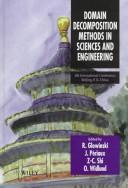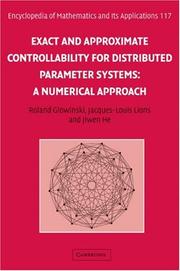| Listing 1 - 10 of 17 | << page >> |
Sort by
|
Book
ISBN: 9783540775065 Year: 2008 Publisher: Berlin Springer
Abstract | Keywords | Export | Availability | Bookmark
 Loading...
Loading...Choose an application
- Reference Manager
- EndNote
- RefWorks (Direct export to RefWorks)
Book
ISBN: 1281512605 9786611512606 1402087586 1402087578 9048179793 Year: 2008 Publisher: Dordrecht : Springer,
Abstract | Keywords | Export | Availability | Bookmark
 Loading...
Loading...Choose an application
- Reference Manager
- EndNote
- RefWorks (Direct export to RefWorks)
This book is dedicated to Olivier Pironneau. For more than 250 years partial differential equations have been clearly the most important tool available to mankind in order to understand a large variety of phenomena, natural at first and then those originating from human activity and technological development. Mechanics, physics and their engineering applications were the first to benefit from the impact of partial differential equations on modeling and design, but a little less than a century ago the Schrödinger equation was the key opening the door to the application of partial differential equations to quantum chemistry, for small atomic and molecular systems at first, but then for systems of fast growing complexity. Mathematical modeling methods based on partial differential equations form an important part of contemporary science and are widely used in engineering and scientific applications. In this book several experts in this field present their latest results and discuss trends in the numerical analysis of partial differential equations. The first part is devoted to discontinuous Galerkin and mixed finite element methods, both methodologies of fast growing popularity. They are applied to a variety of linear and nonlinear problems, including the Stokes problem from fluid mechanics and fully nonlinear elliptic equations of the Monge-Ampère type. Numerical methods for linear and nonlinear hyperbolic problems are discussed in the second part. The third part is concerned with domain decomposition methods, with applications to scattering problems for wave models and to electronic structure computations. The next part is devoted to the numerical simulation of problems in fluid mechanics that involve free surfaces and moving boundaries. The finite difference solution of a problem from spectral geometry has also been included in this part. Inverse problems are known to be efficient models used in geology, medicine, mechanics and many other natural sciences. New results in this field are presented in the fifth part. The final part of the book is addressed to another rapidly developing area in applied mathematics, namely, financial mathematics. The reader will find in this final part of the volume, recent results concerning the simulation of finance related processes modeled by parabolic variational inequalities.
Differential equations, Partial. --- Engineering mathematics. --- Physics. --- Natural philosophy --- Philosophy, Natural --- Physical sciences --- Dynamics --- Engineering --- Engineering analysis --- Mathematical analysis --- Mathematics --- Partial differential equations --- Differential equations, partial. --- Numerical and Computational Physics, Simulation. --- Mathematical and Computational Engineering. --- Partial Differential Equations. --- Mathematical Modeling and Industrial Mathematics. --- Applied mathematics. --- Partial differential equations. --- Mathematical models. --- Models, Mathematical --- Simulation methods --- Modeling --- Numerical simulation
Digital
ISBN: 9780444866806 0444866809 9780080875361 008087536X 1281984892 9781281984890 9786611984892 6611984895 Year: 1983 Publisher: New York, N.Y. Sole distributors for the U.S.A. and Canada, Elsevier Science Pub. Co
Abstract | Keywords | Export | Availability | Bookmark
 Loading...
Loading...Choose an application
- Reference Manager
- EndNote
- RefWorks (Direct export to RefWorks)
The purpose of this volume is to present the principles of the Augmented Lagrangian Method, together with numerous applications of this method to the numerical solution of boundary-value problems for partial differential equations or inequalities arising in Mathematical Physics, in the Mechanics of Continuous Media and in the Engineering Sciences.

Abstract | Keywords | Export | Availability | Bookmark
 Loading...
Loading...Choose an application
- Reference Manager
- EndNote
- RefWorks (Direct export to RefWorks)
Decomposition method --- Differential equations, Partial --- Congresses
Book
Abstract | Keywords | Export | Availability | Bookmark
 Loading...
Loading...Choose an application
- Reference Manager
- EndNote
- RefWorks (Direct export to RefWorks)
Book
Year: 1976 Publisher: Berlin, Heidelberg, New York Springer
Abstract | Keywords | Export | Availability | Bookmark
 Loading...
Loading...Choose an application
- Reference Manager
- EndNote
- RefWorks (Direct export to RefWorks)
Book
Year: 1976 Publisher: Berlin, Heidelberg, New York Springer
Abstract | Keywords | Export | Availability | Bookmark
 Loading...
Loading...Choose an application
- Reference Manager
- EndNote
- RefWorks (Direct export to RefWorks)
Book
Year: 1974 Publisher: Berlin, Heidelberg, New York Springer
Abstract | Keywords | Export | Availability | Bookmark
 Loading...
Loading...Choose an application
- Reference Manager
- EndNote
- RefWorks (Direct export to RefWorks)

ISBN: 9780521885720 0521885728 9780511721595 9781107089785 1107089786 0511721595 9781107096073 1107096073 113988347X 1107101689 1107104106 1107093015 Year: 2008 Volume: 117 Publisher: Cambridge, UK New York
Abstract | Keywords | Export | Availability | Bookmark
 Loading...
Loading...Choose an application
- Reference Manager
- EndNote
- RefWorks (Direct export to RefWorks)
The behaviour of systems occurring in real life is often modelled by partial differential equations. This book investigates how a user or observer can influence the behaviour of such systems mathematically and computationally. A thorough mathematical analysis of controllability problems is combined with a detailed investigation of methods used to solve them numerically, these methods being validated by the results of numerical experiments. In Part I of the book the authors discuss the mathematics and numerics relating to the controllability of systems modelled by linear and non-linear diffusion equations; Part II is dedicated to the controllability of vibrating systems, typical ones being those modelled by linear wave equations; finally, Part III covers flow control for systems governed by the Navier-Stokes equations modelling incompressible viscous flow. The book is accessible to graduate students in applied and computational mathematics, engineering and physics; it will also be of use to more advanced practitioners.
Control theory --- Distributed parameter systems --- Differential equations, Partial --- Numerical solutions --- Control theory. --- Distributed parameter systems. --- Systems, Distributed parameter --- Engineering systems --- System analysis --- Numerical analysis --- Dynamics --- Machine theory --- Numerical solutions. --- Differential equations, Partial - Numerical solutions
Book
Abstract | Keywords | Export | Availability | Bookmark
 Loading...
Loading...Choose an application
- Reference Manager
- EndNote
- RefWorks (Direct export to RefWorks)
| Listing 1 - 10 of 17 | << page >> |
Sort by
|

 Search
Search Feedback
Feedback About UniCat
About UniCat  Help
Help News
News